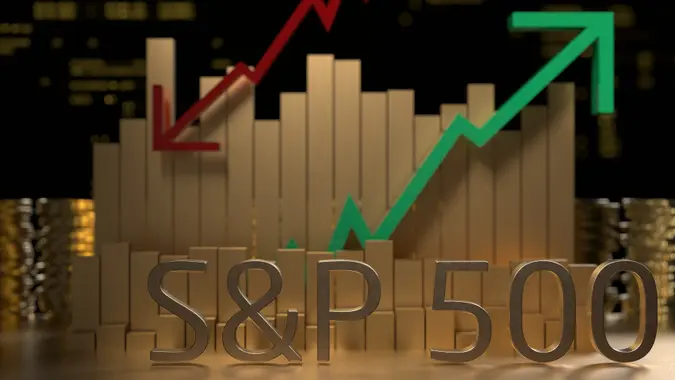What’s The Difference Between A Bear Market vs Bull Market?
Commitment to Our Readers
GOBankingRates' editorial team is committed to bringing you unbiased reviews and information. We use data-driven methodologies to evaluate financial products and services - our reviews and ratings are not influenced by advertisers. You can read more about our editorial guidelines and our products and services review methodology.

20 Years
Helping You Live Richer

Reviewed
by Experts

Trusted by
Millions of Readers
If you’re a novice investor, you’ve likely heard the terms “bull market” and “bear market” tossed around. The problem is that the terms are so ubiquitous that they are rarely explained, even by those using them. They clearly refer to different types of markets and economic conditions, but what do those terms really mean, and how did they originate?
In a nutshell, a bull market refers to when market prices are rising, while a bear market sees the opposite. If you’re an investor, it’s important to be able to identify market trends, like bull and bear markets, so you can be best positioned to profit or minimize losses.
Here’s a look at what a bull market and bear market really are and, more importantly, how they can affect your investment portfolio. Once you learn the difference between the two, you’ll be on your way to learning how to invest like a master.
What Is a Bull Market?
Characteristics of a Bull Market
If you’re an investor, a bull market is a very good thing. In bullish times, stock market prices are in a well-defined uptrend. Although different investors and commentators have different definitions of what exactly a bull market is, the U.S. Securities & Exchange Commission defines a bull market as a rise of 20% or more in a broad market index over at least two months. In a general sense, however, a bull market is one in which a large percentage of stocks are moving upwards over a sustained period of time. A bull market is usually an indication of a strong economy, as stocks move generally move up ahead of or coincidental with a growing economy.
While this sweeping definition may refer to the market as a whole, investors can also consider different segments of the market bullish, even if the broad market is in decline. For example, the Standard & Poor’s 500 index is divided into 11 sectors. It’s entirely possible that the technology sector is in a bull market while the utility sector is trending lower, for example.
In addition to its strict stock market definition, a bull market is generally accompanied by a booming economy and general optimism among consumers and investors. Known as the wealth effect, this theory posits that when asset values like home prices and the stock market rise, consumers feel more confident and spend more money. This, in turn, creates additional economic expansion, which can help fuel the bull market even further.
Historical Examples of Bull Markets
Bull markets tend to last a number of years, but the longest one in history ran from 2009 to 2020. After the housing market collapse triggered a financial armageddon in the markets in 2008, markets recovered strongly and continued to run for more than an entire decade. During that 11-year period, the S&P 500 posted a compound annual growth rate of 16%, according to data from CMC Markets. All-in-all, the S&P 500 gained over 400% over that time period.
Another big market boom occurred between 1991 and 2000 — in fact, this was the most profitable bull market in history, returning 417% to investors in just over 113 months. This bull run was triggered by the end of the Cold War and the huge boom in technology that ushered in the digital age we have today.
What Is a Bear Market?
Characteristics of a Bear Market
A bear market is the opposite of a bull market in every way.
Generally defined as a drop of 20% or more in stock prices, bear markets also bring about economic pessimism and reduced consumer spending, factors that can contribute to extending a bear market. During a bear market, investors want to protect their savings. This can lead to more money being pulled out of the stock market, driving prices down even further.
Bear markets are more extreme versions of corrections, which are defined as a drop of 10% to 20% in the general market. However, bear markets can be much more severe. During the Great Recession at the end of the 2000s, for example, market prices dropped by more than 50%. Things were even worse during the Great Depression, with prices falling by an astonishing 83%.
Historical Examples of Bear Markets
The stock market crash of 1929 is probably the most famous example of a bear market. The selloff was so great that it triggered the Great Depression, which lasted for the bulk of the following decade. According to U.S. News and World Report, the “Composite Index,” which was the 90-strong precursor to the modern-day S&P 500, fell an incredible 83% over a 783-day period.
The financial crisis of 2007-09 is one of the more modern examples of the damage that a bear market can do. Between Oct. 2007 and Mar. 2009, the S&P 500 fell a whopping 47% and dragged the economy into a deep recession that lasted 18 months.
Key Differences Between Bull and Bear Markets
The direction of market prices is the key differentiator between bull and bear markets. When prices trend higher, it represents a bull market. When prices drop by 20% or more, it’s indicative of a bear market.
Beyond simple market pricing, however, there are additional characteristics that mark the difference between a bull and a bear market. In a bull market, investors are confident. They tend to continually invest, pushing up market volumes and turning sentiment positive. Bull markets are also typically accompanied by strong economic growth. Employment tends to be low, wages tend to be rising, and corporate earnings are on an uptrend.
The opposite is true during bear markets. Sentiment is negative, market volumes drop, and investors get fearful. Bear markets are often a prelude to or accompanied by poor economic conditions, such as a recession.
How To Identify Market Trends
Economic Indicators
The interaction between the economy and the stock market can be complicated. However, a bull market tends to go hand in hand with rising gross domestic product (GDP), low unemployment rates, and low-to-moderate inflation. This is because these are the conditions that contribute to economic growth at companies. Economic growth leads to higher corporate profit,s which in turn tends to lead to higher wages. And as consumer spending is the single most significant portion of the U.S. economy, more money in the pockets of Americans leads to higher spending.
The opposite is also true. If the economy is in a recession, wages are falling, unemployment is rising, and consumer confidence is low, you’re likely to find a bear market for stocks.
One thing to note is that the stock market is a leading indicator. This means that stocks tend to move before changes in the economy are actually visible. For example, bull markets tend to end before the economy actually weakens, while bear markets tend to end before the economy shows definite signs of recovery.
Market Indicators
If you’re looking to identify a market trend, there’s no better place to look than at the actual stock market itself. While a market that’s down 20% or more is a prominent bear, a sharp selloff on high volume could be an indication that a bear market is lurking. This is especially true when it’s coincident with poor news about the economy.
Trading volumes during bull markets tend to remain high as investors are enthusiastic about making money. However, bear markets tend to have lower trading volumes, as investors lose interest in participating in a market that seems to endlessly lose money.
Investment Strategies for Bull and Bear Markets
Strategies During Bull Markets
A bull market is the time you want to be sure that you are invested. If you’re a long-term investor, it means you should most definitely hold on to your stocks and enjoy the bull run. If you can handle the risk, you might even consider investing in high-growth stocks, like those found in the technology industry, to participate in even more significant upside.
Strategies During Bear Markets
You’ll know you’re in a real bear market when you feel as if you made a mistake and should get out of the stock market. Major bear markets can affect investors emotionally, as it’s hard to see values go down, and it feels like it will never end. In this type of environment, however, you can still take some steps to preserve your principal. Diversifying your account is a good option, as it can help make your account less volatile and may even smooth out the ride a bit, as a portion of your account may even rise when there’s a bear market in stocks.
Bonds, for example, are an excellent diversification tool and often trade up in value during stock bear markets as investors flock to safer investments. Defensive stocks also tend to hold up better in bear markets. While consumers might cut back on vacations and diamond jewelry when the economy is bad, people still need to eat and wash their hair and keep the lights on. These are the types of companies that tend to fare well during bear markets.
Common Misconceptions
Although the market’s natural long-term tendency is to go up, bull markets do not last forever. It may seem like that most of the time, as the market is generally bullish, and uptrends last much longer than downtrends. But it’s just a natural part of the business cycle that eventually, bull markets end, and the bears take over.
It’s also important to note that a bull market doesn’t mean that prices continually go straight up. Even within a bull market, it’s fairly common that a 10% to 15% selloffs occur. It’s only when the 20% threshold is broken that most market observers dub a bull market to be over.
Another common misconception is that you should sell all of your investments in a bear market. For starters, many investments, such as precious metals, bonds, or other alternative investments, can actually go up during bear markets. But even some stocks go up during bear markets. Picking the right ones can be tricky, but there are always some stocks that rise even through a bear market.
 Written by
Written by  Edited by
Edited by 


























